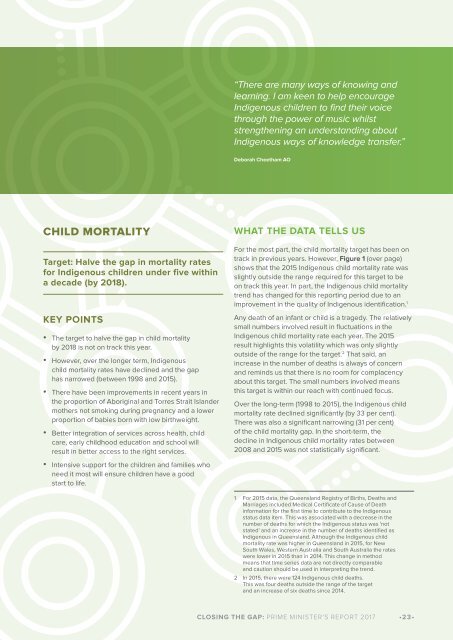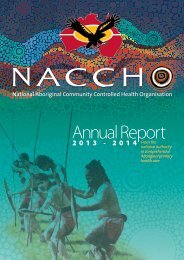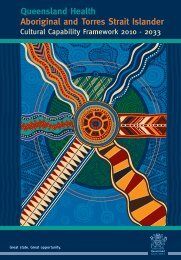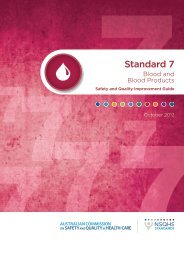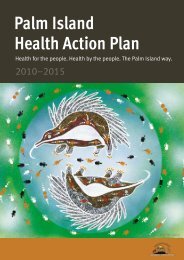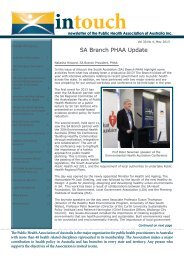CLOSING THE GAP
ctg-report-2017
ctg-report-2017
You also want an ePaper? Increase the reach of your titles
YUMPU automatically turns print PDFs into web optimized ePapers that Google loves.
“There are many ways of knowing and<br />
learning. I am keen to help encourage<br />
Indigenous children to find their voice<br />
through the power of music whilst<br />
strengthening an understanding about<br />
Indigenous ways of knowledge transfer.”<br />
Deborah Cheetham AO<br />
CHILD MORTALITY<br />
Target: Halve the gap in mortality rates<br />
for Indigenous children under five within<br />
a decade (by 2018).<br />
KEY POINTS<br />
• The target to halve the gap in child mortality<br />
by 2018 is not on track this year.<br />
• However, over the longer term, Indigenous<br />
child mortality rates have declined and the gap<br />
has narrowed (between 1998 and 2015).<br />
• There have been improvements in recent years in<br />
the proportion of Aboriginal and Torres Strait Islander<br />
mothers not smoking during pregnancy and a lower<br />
proportion of babies born with low birthweight.<br />
• Better integration of services across health, child<br />
care, early childhood education and school will<br />
result in better access to the right services.<br />
WHAT <strong>THE</strong> DATA TELLS US<br />
For the most part, the child mortality target has been on<br />
track in previous years. However, Figure 1 (over page)<br />
shows that the 2015 Indigenous child mortality rate was<br />
slightly outside the range required for this target to be<br />
on track this year. In part, the Indigenous child mortality<br />
trend has changed for this reporting period due to an<br />
improvement in the quality of Indigenous identification. 1<br />
Any death of an infant or child is a tragedy. The relatively<br />
small numbers involved result in fluctuations in the<br />
Indigenous child mortality rate each year. The 2015<br />
result highlights this volatility which was only slightly<br />
outside of the range for the target. 2 That said, an<br />
increase in the number of deaths is always of concern<br />
and reminds us that there is no room for complacency<br />
about this target. The small numbers involved means<br />
this target is within our reach with continued focus.<br />
Over the long-term (1998 to 2015), the Indigenous child<br />
mortality rate declined significantly (by 33 per cent).<br />
There was also a significant narrowing (31 per cent)<br />
of the child mortality gap. In the short-term, the<br />
decline in Indigenous child mortality rates between<br />
2008 and 2015 was not statistically significant.<br />
• Intensive support for the children and families who<br />
need it most will ensure children have a good<br />
start to life.<br />
1 For 2015 data, the Queensland Registry of Births, Deaths and<br />
Marriages included Medical Certificate of Cause of Death<br />
information for the first time to contribute to the Indigenous<br />
status data item. This was associated with a decrease in the<br />
number of deaths for which the Indigenous status was 'not<br />
stated' and an increase in the number of deaths identified as<br />
Indigenous in Queensland. Although the Indigenous child<br />
mortality rate was higher in Queensland in 2015, for New<br />
South Wales, Western Australia and South Australia the rates<br />
were lower in 2015 than in 2014. This change in method<br />
means that time series data are not directly comparable<br />
and caution should be used in interpreting the trend.<br />
2 In 2015, there were 124 Indigenous child deaths.<br />
This was four deaths outside the range of the target<br />
and an increase of six deaths since 2014.<br />
<strong>CLOSING</strong> <strong>THE</strong> <strong>GAP</strong>: PRIME MINISTER'S REPORT 2017<br />
•23•


